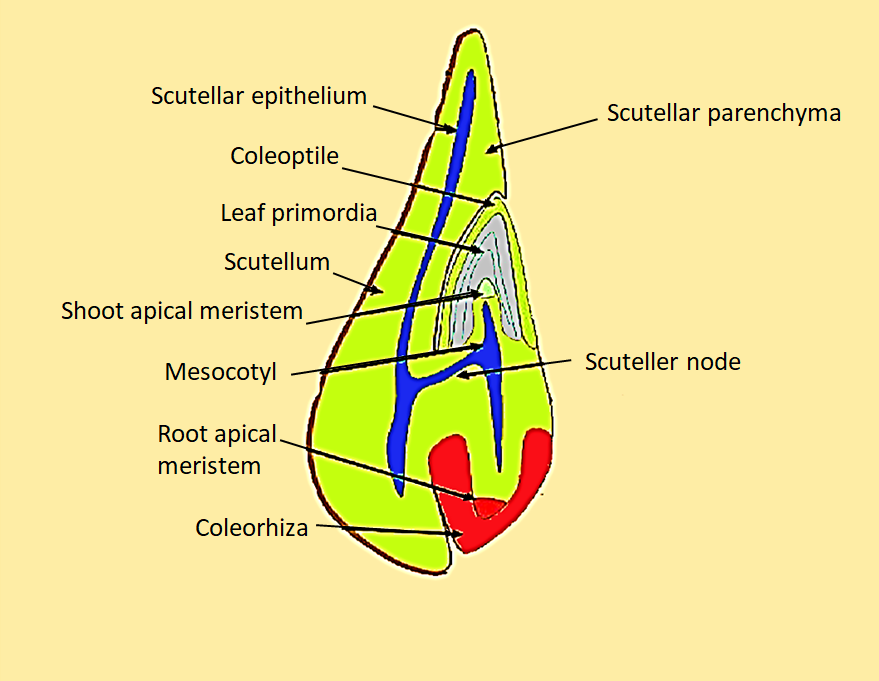Answer
400.2k+ views
Hint: A modified cotyledon present in maize is a large, shield- shaped structure and helps in the absorption of nutrients from the endosperm. These are commonly present in monocotyledon seed.
Complete answer:
In the seeds of maize, the embryo is small and is located in a groove at one end of the endosperm. It consists of one large and shield- shaped cotyledon known as Scutellum and a short axis with a Plumule (represent the future shoot) and radicle (future roots) . Scutellum absorbs the nutrients from the endosperm of the seed and thus, plays an important role is the nourishment of the seedling. The plumule is enclosed in sheaths called coleoptile and the radicle is enclosed in a sheath known as coleorhiza. The seed coat is membranous and generally fused with the fruit wall. The endosperm and embryo are present below the grain covering. The endosperm is bulky and stores food.

Figure: Scutellum of maize
So, the answer is, ‘Scutellum’.
Additional Information: - Monocots are marked by seeds with single cotyledons with parallel venation on leaves and adventitious roots. - Monocot lacks cambium and unlike dicot, these plants grow from inside. - Monocot tends to grow into a herbaceous plant. They grow quickly and stay soft and pliable except for bamboo.
Note: - The scutellum is a believer to be a protein transporter that facilitates starch movement from the endosperm to the embryo. - Scutellum arises from octant cells which also give rise to the cotyledon. - Monocots are the plants that sprout a single leaf from their seeds during germination.
Complete answer:
In the seeds of maize, the embryo is small and is located in a groove at one end of the endosperm. It consists of one large and shield- shaped cotyledon known as Scutellum and a short axis with a Plumule (represent the future shoot) and radicle (future roots) . Scutellum absorbs the nutrients from the endosperm of the seed and thus, plays an important role is the nourishment of the seedling. The plumule is enclosed in sheaths called coleoptile and the radicle is enclosed in a sheath known as coleorhiza. The seed coat is membranous and generally fused with the fruit wall. The endosperm and embryo are present below the grain covering. The endosperm is bulky and stores food.

Figure: Scutellum of maize
So, the answer is, ‘Scutellum’.
Additional Information: - Monocots are marked by seeds with single cotyledons with parallel venation on leaves and adventitious roots. - Monocot lacks cambium and unlike dicot, these plants grow from inside. - Monocot tends to grow into a herbaceous plant. They grow quickly and stay soft and pliable except for bamboo.
Note: - The scutellum is a believer to be a protein transporter that facilitates starch movement from the endosperm to the embryo. - Scutellum arises from octant cells which also give rise to the cotyledon. - Monocots are the plants that sprout a single leaf from their seeds during germination.
Recently Updated Pages
How do you arrange NH4 + BF3 H2O C2H2 in increasing class 11 chemistry CBSE

Is H mCT and q mCT the same thing If so which is more class 11 chemistry CBSE

What are the possible quantum number for the last outermost class 11 chemistry CBSE

Is C2 paramagnetic or diamagnetic class 11 chemistry CBSE

What happens when entropy reaches maximum class 11 chemistry JEE_Main

Calculate the volume occupied by 88 gram of CO2 at class 11 chemistry CBSE



